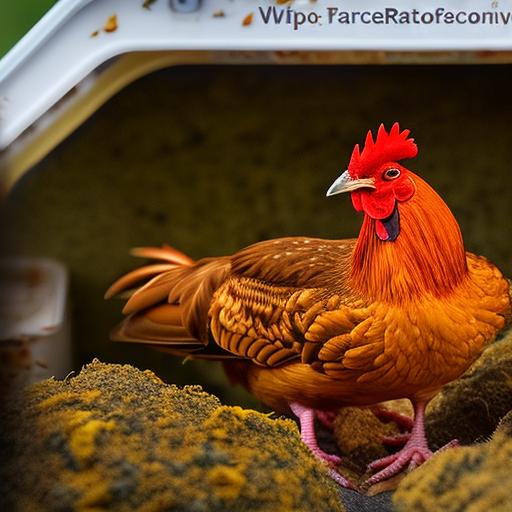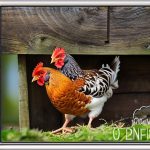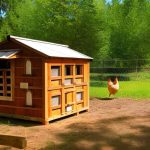Insulation is a crucial aspect of maintaining a healthy and comfortable environment for your chickens in their coop. Just like humans, chickens need a well-insulated space to protect them from extreme temperatures and weather conditions. Insulation helps to regulate the temperature inside the coop, keeping it warm in the winter and cool in the summer. It also helps to prevent drafts and moisture buildup, which can lead to respiratory issues and other health problems for your chickens. In this article, we will explore the importance of insulation for chicken coops, the different types of insulation materials available, factors to consider when choosing insulation, and tips for installation and maintenance.
Understanding the Importance of Insulation for Your Chicken Coop
Insulation plays a vital role in maintaining the health and comfort of your chickens. Chickens are sensitive to temperature fluctuations, and extreme cold or heat can be detrimental to their well-being. In cold weather, proper insulation helps to retain heat inside the coop, preventing frostbite and other cold-related illnesses. In hot weather, insulation helps to keep the coop cool by blocking out excess heat from the sun.
A well-insulated chicken coop also helps to regulate humidity levels. Excessive moisture can lead to mold growth and respiratory issues for your chickens. Insulation helps to prevent condensation from forming inside the coop, reducing the risk of respiratory problems.
Types of Insulation Materials for Chicken Coops
There are several types of insulation materials that can be used for chicken coops. The most common ones include:
1. Fiberglass: Fiberglass insulation is made from fine glass fibers that are woven together. It is a popular choice due to its affordability and availability. Fiberglass insulation is effective at trapping heat and is resistant to moisture. However, it can be irritating to handle without proper protective gear.
2. Foam Board: Foam board insulation is made from rigid panels of polystyrene or polyurethane foam. It is lightweight, easy to install, and provides excellent insulation. Foam board insulation is resistant to moisture and pests. However, it can be more expensive than other types of insulation.
3. Reflective Foil: Reflective foil insulation consists of a layer of aluminum foil sandwiched between layers of bubble wrap or foam. It reflects heat away from the coop in hot weather and helps to retain heat in cold weather. Reflective foil insulation is easy to install and is resistant to moisture. However, it may not provide as much insulation as other materials.
Factors to Consider When Choosing Insulation for Your Chicken Coop
When choosing insulation for your chicken coop, there are several factors to consider:
1. Climate and Weather Conditions: The climate and weather conditions in your area will determine the type and amount of insulation you need. If you live in a cold climate, you will need more insulation to keep the coop warm during winter. If you live in a hot climate, you will need insulation that helps to keep the coop cool in the summer.
2. Size and Layout of Your Chicken Coop: The size and layout of your chicken coop will also affect your insulation needs. Larger coops may require more insulation to maintain a consistent temperature throughout the space. The layout of the coop will determine where insulation needs to be installed, such as walls, ceiling, and floor.
3. Budget and Personal Preferences: Your budget and personal preferences will also play a role in choosing insulation for your chicken coop. Some materials may be more expensive than others, so it’s important to consider your budget when making a decision. Additionally, you may have personal preferences regarding the type of insulation material you want to use.
How to Measure and Calculate Insulation Requirements for Your Coop
Before installing insulation in your chicken coop, it’s important to measure and calculate the amount of insulation you will need. Here is a step-by-step guide to help you:
1. Measure the dimensions of your chicken coop, including the length, width, and height of the walls, ceiling, and floor.
2. Calculate the square footage of each surface that needs to be insulated. To calculate the square footage of a rectangular surface, multiply the length by the width. For example, if a wall is 10 feet long and 8 feet high, the square footage would be 80 square feet.
3. Determine the R-value required for your climate. The R-value measures the insulation’s resistance to heat flow. The higher the R-value, the better the insulation. The R-value required will depend on your climate and weather conditions. Consult with a local expert or refer to building codes for guidance.
4. Calculate the total R-value needed by multiplying the square footage of each surface by the desired R-value. For example, if a wall has a square footage of 80 square feet and you want an R-value of 20, the total R-value needed would be 1,600.
5. Choose insulation materials that meet or exceed the required R-value for each surface.
Insulating the Walls and Ceiling of Your Chicken Coop
Insulating the walls and ceiling of your chicken coop is essential for maintaining a comfortable environment for your chickens. Here are some tips for insulating these areas:
1. Start by cleaning and preparing the surfaces. Remove any debris or loose materials from the walls and ceiling.
2. Measure and cut insulation panels to fit each wall and ceiling section. Leave a small gap around windows and doors to allow for proper ventilation.
3. Attach the insulation panels to the walls and ceiling using adhesive or staples. Make sure they are securely fastened and cover all areas evenly.
4. Seal any gaps or seams with caulk or foam sealant to prevent drafts and moisture from entering.
5. Install a vapor barrier over the insulation to prevent condensation. This can be a plastic sheet or specialized vapor barrier material.
6. Finish the walls and ceiling with a protective covering, such as plywood or drywall, to provide additional insulation and protection.
Insulating the Floor of Your Chicken Coop
Insulating the floor of your chicken coop is just as important as insulating the walls and ceiling. Here are different methods for insulating the floor:
1. Raised Floor: One method is to create a raised floor using wooden beams or concrete blocks. Insulate the space between the beams or blocks with insulation material, such as fiberglass or foam board. This helps to prevent cold air from seeping in through the ground.
2. Insulated Flooring: Another option is to use insulated flooring panels specifically designed for chicken coops. These panels have built-in insulation and are easy to install. They provide a barrier between the ground and the coop, helping to maintain a consistent temperature.
3. Deep Litter Method: The deep litter method is an alternative to traditional insulation. Instead of insulating the floor, you create a thick layer of organic material, such as straw or wood shavings, on the floor of the coop. As the litter decomposes, it generates heat, providing natural insulation for your chickens.
Tips for Installing Insulation in Your Chicken Coop
When installing insulation in your chicken coop, it’s important to take safety precautions and follow best practices. Here are some tips to keep in mind:
1. Wear protective gear, such as gloves, goggles, and a mask, when handling insulation materials. Some materials can be irritating to the skin and respiratory system.
2. Follow manufacturer instructions for installation. Different insulation materials may have specific requirements for installation and fastening.
3. Ensure proper ventilation during installation to prevent exposure to fumes or dust from insulation materials.
4. Seal all gaps and seams with caulk or foam sealant to prevent drafts and moisture from entering.
5. Regularly inspect the insulation for any signs of damage or wear. Replace or repair insulation as needed to maintain its effectiveness.
Maintaining Proper Ventilation in Your Insulated Chicken Coop
While insulation is important for maintaining a comfortable temperature in your chicken coop, it’s equally important to ensure proper ventilation. Ventilation helps to remove stale air, moisture, and odors from the coop, preventing respiratory issues and other health problems for your chickens. Here are some tips for maintaining proper ventilation:
1. Install vents or windows in the coop to allow fresh air to enter and stale air to exit. Place them strategically to promote airflow without creating drafts.
2. Use wire mesh or hardware cloth to cover vents and windows to prevent predators from entering.
3. Clean the coop regularly to remove droppings and other debris that can contribute to poor air quality.
4. Avoid overcrowding the coop, as this can lead to increased humidity and ammonia levels.
5. Monitor temperature and humidity levels regularly to ensure they are within a healthy range for your chickens.
How to Monitor Temperature and Humidity Levels in Your Coop
Monitoring temperature and humidity levels in your chicken coop is essential for the health and well-being of your chickens. Here are some tools and equipment you can use:
1. Thermometer: Use a thermometer to measure the temperature inside the coop. Place it at chicken height for accurate readings.
2. Hygrometer: A hygrometer measures the humidity level in the coop. It can help you determine if the humidity is too high or too low.
3. Wireless Sensors: Wireless sensors are a convenient way to monitor temperature and humidity levels remotely. They can send real-time data to your smartphone or computer, allowing you to make adjustments as needed.
4. Data Loggers: Data loggers are devices that record temperature and humidity data over a period of time. They can provide valuable insights into the conditions inside your coop and help you identify any patterns or trends.
Additional Tips for Keeping Your Chickens Warm and Happy During Winter
In addition to insulation, there are other ways to keep your chickens warm and happy during winter. Here are some tips:
1. Provide a heat source: Consider using a heat lamp or heated pad to provide additional warmth inside the coop. Make sure to follow safety guidelines and keep the heat source away from flammable materials.
2. Use deep litter method: As mentioned earlier, the deep litter method can generate heat as the litter decomposes. This can provide natural insulation and warmth for your chickens.
3. Provide extra bedding: Increase the amount of bedding in the coop during winter to provide additional insulation and warmth.
4. Use draft guards: Install draft guards around windows, doors, and other openings to prevent cold air from entering the coop.
5. Insulate waterers: Insulate waterers to prevent them from freezing. You can use foam insulation or heated waterers specifically designed for cold weather.
Common Mistakes to Avoid When Insulating Your Chicken Coop
When insulating your chicken coop, it’s important to avoid common mistakes that can compromise the effectiveness of the insulation. Here are some mistakes to avoid:
1. Insufficient insulation: Make sure you have enough insulation to provide adequate protection against temperature fluctuations. Insufficient insulation can lead to drafts and temperature extremes inside the coop.
2. Poor installation: Improper installation of insulation can result in gaps, seams, or loose panels that allow drafts and moisture to enter. Follow manufacturer instructions and take your time during installation to ensure a proper fit.
3. Neglecting ventilation: While insulation is important, it should not be used as a substitute for proper ventilation. Neglecting ventilation can lead to poor air quality and health issues for your chickens.
4. Using the wrong insulation material: Each insulation material has its pros and cons, and not all are suitable for chicken coops. Choose a material that is appropriate for your climate, budget, and personal preferences.
5. Ignoring maintenance: Insulation requires regular maintenance to ensure its effectiveness. Inspect the insulation regularly for any signs of damage or wear, and make repairs or replacements as needed.
Insulation is a crucial aspect of maintaining a healthy and comfortable environment for your chickens in their coop. It helps to regulate temperature, prevent drafts, and reduce moisture buildup. By understanding the importance of insulation, choosing the right materials, and following best practices for installation and maintenance, you can create a cozy and safe space for your chickens year-round. Remember to consider factors such as climate, coop size, and personal preferences when choosing insulation materials. Regularly monitor temperature and humidity levels, maintain proper ventilation, and implement additional measures to keep your chickens warm and happy during winter. With proper insulation and care, your chickens will thrive in their well-insulated coop.
Meet Walter, the feathered-friend fanatic of Florida! Nestled in the sunshine state, Walter struts through life with his feathered companions, clucking his way to happiness. With a coop that’s fancier than a five-star hotel, he’s the Don Juan of the chicken world. When he’s not teaching his hens to do the cha-cha, you’ll find him in a heated debate with his prized rooster, Sir Clucks-a-Lot. Walter’s poultry passion is no yolk; he’s the sunny-side-up guy you never knew you needed in your flock of friends!







